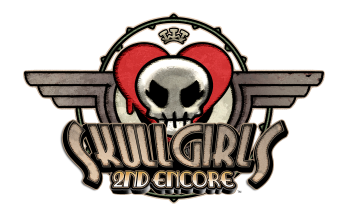

Life and Damage
Prominently displayed on the HUD, life is the most important thing to keep track of while playing Skullgirls. When you take too much damage you lose!
Team Size
Selecting team size occurs before choosing characters and can have dramatic effects on gameplay. Picking at least 2 characters allows tagging between characters and techniques that require a teammate such as Ensembles, Blockbuster Sequels, and Stunt Doubles. Picking a 2 character team will have a total life advantage over a solo character. A 3 character team will always have a total life advantage over a duo or a solo team. In addition to the life advantages from team size the ability to simply Tag Out enables an off screen character to heal recoverable damage, allowing an even greater total health advantage to larger teams.
Despite the clear total life advantage for a smaller team, the tactical disadvantage from playing without Ensembles, and the inability to tag out of a bad situation, a solo team can still compete. The significant damage boost can lead to devastating combos from a single character when facing a team of weaker opponents. Newer players may feel more comfortable selecting a single character to free themselves from the more complicated strategy and risks of using Ensembles. Even an experienced player may want to stick with one character if they are true master of that character.
The exact individual character life and damage differences between solo, duo, and trio teams scale differently depending on the match up. The values do not scale linearly, allowing the consistent timer for all match ups and team size combinations.
| File:Skullgirlsnethealth4.png |
| worldjem's comparison chart for all possible team sizes and match ups. |
Recoverable Damage
After characters take any damage, the red portion of their life bar represents the amount of recoverable damage dealt to that character. All attacks, including chip damage from blocked attacks, deal some portion of recoverable damage. All {{#motion:throw}} attacks deal 100% recoverable damage. Life recovery begins when a character Tags Out or is otherwise off screen, starting at 90f after leaving. This recovery is always percentage based, at a rate of .5% per 30f. Team size and the remaining life totals do not affect life recovery in any way.
Ensemble characters take all damage as recoverable damage. During an Ensemble lockout, which occurs after an Ensemble character takes damage or the team gets hit by an Outtake, the defending team loses the ability to heal recoverable damage for the 300f duration of Ensemble lockout.
Solo character teams do not have the passive damage recovery of a larger team because a solo cannot tag out. In solo vs solo team matches, recoverable damage is not used in any way and does not display on the life bar. When a solo team faces a larger team, the solo team can retain up to 1/3 of total health as recoverable damage against a 3 character team and up to 1/2 total health against 2 characters. Outtakes use the solo's team recoverable damage, which have additional properties in these matches; hitting the larger team with an Outtake heals recoverable damage for the solo team while getting hit by an outtake will remove all recoverable damage from the solo team.
If a character takes non-recoverable damage for any reason, even if it's a single point of chip damage, life recovery cannot take the team back up to 100% and the team cannot get a "perfect" message when winning the match.
Chip Damage
All Special and Blockbuster moves cause some amount of chip damage when they are blocked. The amount of chip damage per move is specific to the move, is subject to all normal damage modifiers and scaling, and deals a portion of recoverable damage. Everything that can do chip damage must do a minimum 1 point of damage. Pushblock prevents the recoverable portion of chip damage, but nothing completely prevents it.
Damage Scaling
Attack damage scales down at a compounding 87.5% per hit after the 3rd hit in a combo. Damage scales to a minimum 27.5% for attacks with base damage of 1000 and above and 20% of base damage for hits under 1000 base damage. Minimum damage for any hit is always 1 point. A {{#motion:throw}} will freeze scaling for the duration of the throw, but scale the combo to 50% afterwards for all Normal Throws and most command throws. Some specific attacks, mostly command throws, scale damage to a set lower value if a combo continues after the attack hits. This forced damage scaling will only occur if the change will lower damage faster than the combo would by default.
Level 3 Blockbusters have minimum damage scaling of 45% and level 5 Blockbusters scale to a 55% minimum, ensuring the attacks deal enough damage to justify their high cost in tension.
Blockbuster Sequels reset damage scaling to 70% at the super flash. {{#motion:proj}} attacks have their scaled damage determined from when they hit, even if left on the screen during the additional super flash.
If an Ensemble attack starts a combo, it sets damage scaling to 66% for the combo. Landing the Ensemble as a counter hit reduces this penalty to 90%.
There is no hit stun scaling, gravity scaling, or any other compounding value that will eventually end a combo in Skullgirls. If trapped in a long combo, the defending player can only look to damage scaling and the Infinite Prevention System to ease the pain.